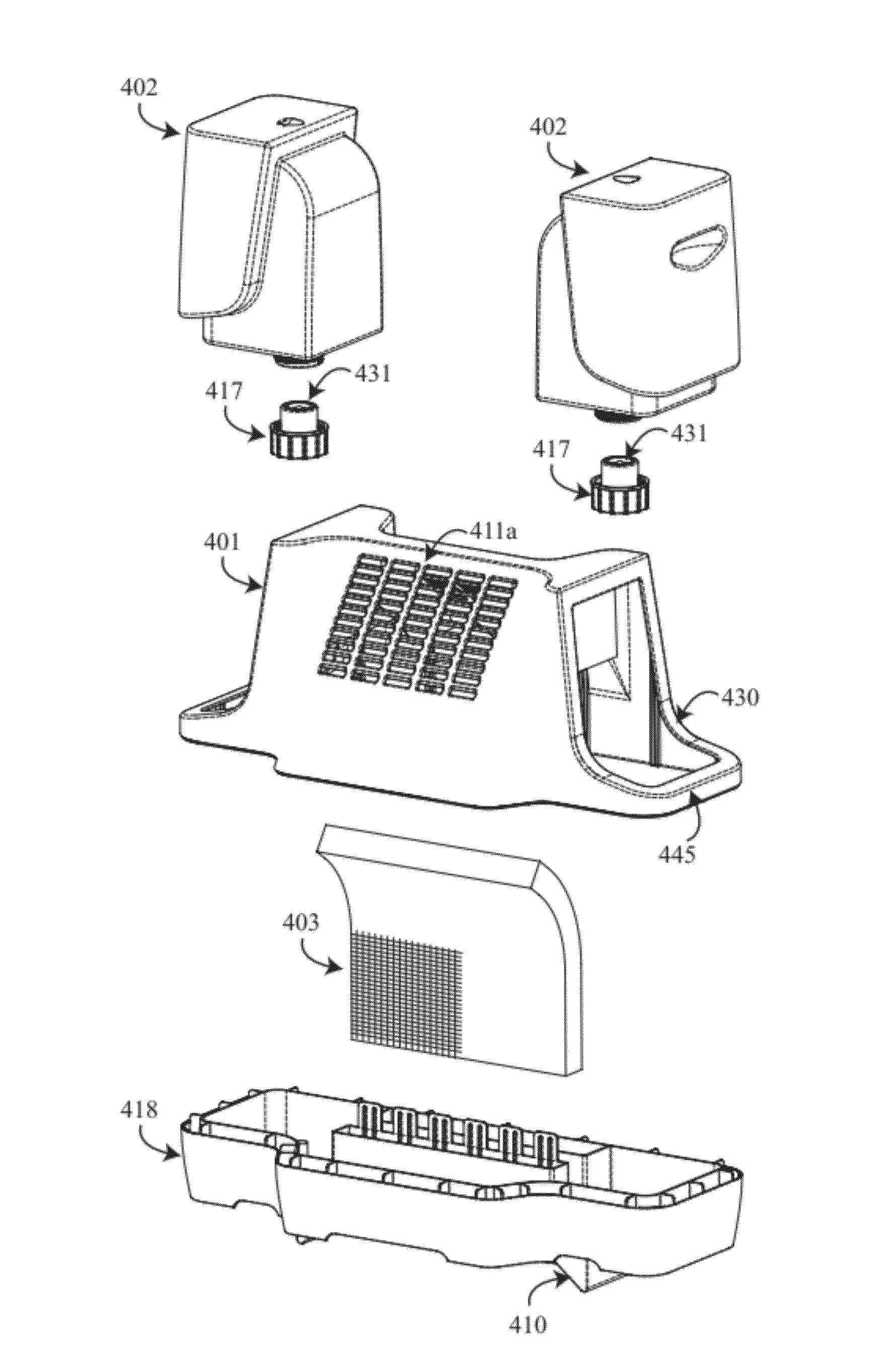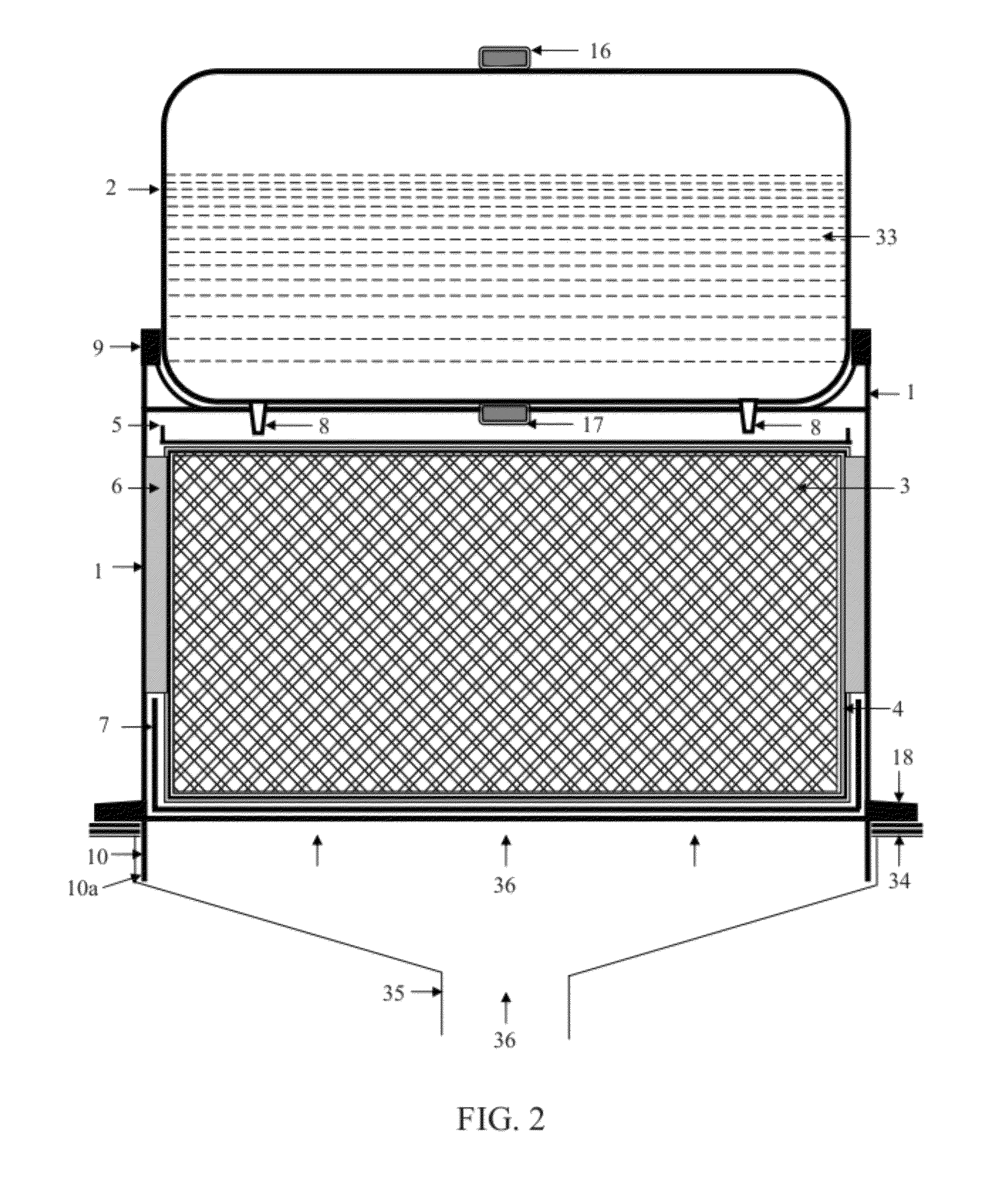Room vent humidifier
a technology of humidifier and room vent, which is applied in the direction of heating types, gas purification by liquid washing, fuel gas production, etc., can solve the problems of not being able to solve the problem in its entirety, reducing the moisture level, and not being able to completely bring the humidity level, so as to prevent overflow and keep the water level low
- Summary
- Abstract
- Description
- Claims
- Application Information
AI Technical Summary
Benefits of technology
Problems solved by technology
Method used
Image
Examples
embodiment 1
[0081]Preferred Embodiment 1 of this invention is illustrated in FIGS. 1-3 and 5-10. In this embodiment, the room humidifier is comprised mainly of casing (1), main water tank (2), evaporative filter element (3), lower water pan (7), and air outlet grill (11). Main water tank (2) and evaporative filter element (3) are located within casing (1) with evaporative filter element (3) being located underneath main water tank (2). Evaporative filter element (3) stands vertically inside the water pan (7) which surrounds a lower edge portion of the filter element. All of the components of this embodiment, including casing (1) and main water tank (2), can be made of plastic for the exception of evaporative filter element (3).
[0082]Casing (1) is the main body of the room vent humidifier on the top of which the main water tank (2) is situated. Casing (1) has projecting tabs on top providing water tank click tabs (9) for the main water tank (2) to slide and click in place.
[0083]The bottom of the...
embodiment 2
[0095]As illustrated in FIG. 4, the humidifier of this Embodiment 2 can be fixed onto a wall vent opening. In this installation, air inlet base (110) is attached to the room wall (37) instead of room floor vent (34) to direct the air flow (36) to evaporative filter element (3). The air corridor is a horizontal straight hollow opening and does not have any air deflector. The casing (101) is fixed on to the room wall (37) with the help of fixing screws (38). The components, installation and operation of the unit remain same as the preferred embodiment except for the above explained differences.
[0096]Optional embodiment of main water tank (102):
[0097]FIG. 9 illustrates an optional main water tank (102) that can be employed within certain embodiments of this invention including the first embodiment. Two major differences in this optional main water tank (102) from main water tank (2) of the first embodiment are:
[0098]1) Use of a float valve assembly (21) to fill the water tank (102) and...
embodiment 3
[0104 of this invention is designed to give air flow in line with the standards of some countries. The main difference of this embodiment compared to the previous embodiments is the way hot air comes out of the humidifier. In this embodiment, hot air is coming out of two sides of the apparatus instead of the front as in the preferred embodiment.
[0105]FIG. 11 and FIG. 12 show respectively a sectionalized front view of this embodiment, and a top plan view of the casing (201) without main water tank (202). The main purpose of this embodiment is to direct air flow through the sides of the humidifier and to the sides of the room rather than only through the front of the humidifier.
[0106]In Embodiment 3, many of the components of the invention remain the same as the preferred embodiment explained above and used in the exact same context; however the following components are duplicated:[0107]Evaporative filter element (3)[0108]Evaporative filter element frame distribution trough (5)[0109]L...
PUM
| Property | Measurement | Unit |
|---|---|---|
| transparent | aaaaa | aaaaa |
| rigidity | aaaaa | aaaaa |
| length | aaaaa | aaaaa |
Abstract
Description
Claims
Application Information
 Login to View More
Login to View More - R&D
- Intellectual Property
- Life Sciences
- Materials
- Tech Scout
- Unparalleled Data Quality
- Higher Quality Content
- 60% Fewer Hallucinations
Browse by: Latest US Patents, China's latest patents, Technical Efficacy Thesaurus, Application Domain, Technology Topic, Popular Technical Reports.
© 2025 PatSnap. All rights reserved.Legal|Privacy policy|Modern Slavery Act Transparency Statement|Sitemap|About US| Contact US: help@patsnap.com



